|
|
|
Sort Order |
|
|
|
Items / Page
|
|
|
|
|
|
|
| Srl | Item |
| 1 |
ID:
117632
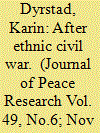

|
|
|
|
|
| Publication |
2012.
|
| Summary/Abstract |
While the study of the causes of civil war is a well-established subdiscipline in international relations, the effects of civil war on society remain less understood. Yet, such effects could have crucial implications for long-term stability and democracy in a country after the reaching of a peace agreement. This article contributes to the understanding of the effects of warfare on interethnic relations, notably attitudes of ethno-nationalism. Two hypotheses are tested: first, that the prevalence of ethno-nationalism is higher after than before the war, and second, that individuals who have been directly affected by the war are more nationalist than others. The variation in ethno-nationalism is examined over time, between countries, and between ethnic groups. Three countries that did not experience conflict on their own territory serve as a control group. The effect of individual war exposure is also tested in the analysis. Sources include survey data from the former Yugoslavia in 1989, shortly before the outbreak of war in Croatia and Bosnia and Herzegovina, and in 2003, some years after the violence in the region ended. Contrary to common beliefs, the study shows that ethno-nationalism does not necessarily increase with ethnic civil war. The individual war experiences are less important than expected.
|
|
|
|
|
|
|
|
|
|
|
|
|
|
|
|
| 2 |
ID:
117630
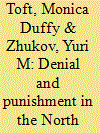

|
|
|
|
|
| Publication |
2012.
|
| Summary/Abstract |
A growing literature on the subnational diffusion of armed conflict rests on the proposition that political violence triggers more violence, in the same locality and elsewhere. Yet state efforts to contain such uprisings remain largely unexplored, theoretically and empirically. Drawing on a mathematical model of epidemics, we formalize the logic of conflict diffusion and derive conditions under which state coercion might limit the spread of insurgent violence. Using a new dataset of insurgent and government violence in Russia's North Caucasus from 2000 to 2008, we evaluate the relative effectiveness of four coercive strategies: (1) denial, which manipulates the costs of expanding insurgent activity to new locations, (2) punishment, which manipulates the costs of sustained fighting in contested areas, (3) denial and punishment, which does both, and (4) no action, which does neither. We find denial to be most effective at containing insurgent violence. Punishment is least effective, and even counterproductive. Not only does such a strategy fail to prevent the spillover of violence to new locations, but it may amplify the risk of continued fighting in contested areas. In the Caucasus, denial is found to be the least inflammatory counter-insurgency option for Russia. For it to succeed, Russia should physically isolate centers of insurgent activity from regions of nonviolence and avoid the temptation of punitive reprisals.
|
|
|
|
|
|
|
|
|
|
|
|
|
|
|
|
| 3 |
ID:
117634
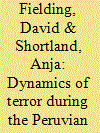

|
|
|
|
|
| Publication |
2012.
|
| Summary/Abstract |
The international community has a declared intention to protect civilians from deliberate violence in civil conflicts. The optimal type of foreign intervention and its optimal timing are likely to depend on the combat strategies of the belligerents. Weak belligerents unable to provide economic incentives and security guarantees to civilians often follow a strategy of intimidation and terror. In this case, foreign financial support for one side could affect the strategies of both sides in several different ways, and the interaction between the two sides' strategies could magnify the resulting impact on civilian casualties. Using a new monthly time-series dataset, we explore the factors associated with variations in the intensity of civilian abuse by participants in the guerrilla war in Peru during the 1980s and 1990s. We show that an increase in civilian abuse by one side was strongly associated with subsequent increases in abuse by the other. In this type of war, foreign intervention could substantially reduce the impact on civilians of a sudden rise in conflict intensity, by moderating the resulting 'cycle of violence'. In practice, foreign interventions had a mixed record in Peru: financial support for the Peruvian military raised the level of violence against civilians, but counter-narcotics aid and development aid reduced it. These effects are consistent with a model in which different types of intervention have different effects on belligerents' resource capacity and on the opportunity cost of fighting.
|
|
|
|
|
|
|
|
|
|
|
|
|
|
|
|
| 4 |
ID:
117633


|
|
|
|
|
| Publication |
2012.
|
| Summary/Abstract |
The allegedly complex relationship between trust and victimization has rarely been modeled and, when done, the effect of trust on victimization has been found not statistically significant. This study finds otherwise, estimating an instrumental model with community data from Cali, Colombia. Cali's dismal levels of victimization were only second to Medellin, the most violent city of the world in the 1990s. But Cali also pioneered a strategy of social capital formation as the backbone of a deliberate public policy to crack down on high levels of crime. This article first develops a model of victimization that includes interpersonal trust as determinant and then instruments interpersonal trust with district-level average trust. We argue that an individual-specific level of trust in his or her community members does not affect the community level of interpersonal trust in the margin. However, the levels - or perceived levels - of interpersonal trust in the community may affect the specific level of trust of an individual in other members of that community, along with personal characteristics and experience. Using GMM estimates, this study finds evidence of a relationship between interpersonal trust and victimization, statistically significant and negative in sign. The result is robust across specifications of trust, victimization, and estimating techniques. We conclude that increasing trust in trusting communities contributes to reducing victimization in its own right, although the effect is modest. Consequently, strengthening interpersonal trust is another bullet to combat victimization but it is not a silver bullet.
|
|
|
|
|
|
|
|
|
|
|
|
|
|
|
|
| 5 |
ID:
117631
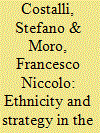

|
|
|
|
|
| Publication |
2012.
|
| Summary/Abstract |
The impact of ethnicity for the onset of conflicts has often been dismissed in the cross-country empirical literature on civil wars. Recently, however, several studies using disaggregated data have reached different conclusions and highlight the importance of the configuration of ethno-national groups. This article follows the latter approach and investigates a different phenomenon: the impact of ethnic heterogeneity on the severity of violence. Using disaggregated data at municipality level in Bosnia and Herzegovina, we perform a quantitative analysis to assess the impact of various indices of heterogeneity on the number of casualties that occurred in the 1992-95 war in the 109 municipalities composing the country. We argue that in a context where ethnicity plays a key role in shaping rivalry among groups, ethnic polarization, in particular, creates strategic incentives for severe violence as armed groups try to create ethnically homogenous territories in the first phase of the war. By also including the temporal dimension in the analysis, we show that ethnic polarization loses its impact as the war evolves over time; therefore, the geographic location of the municipalities becomes the best predictor of severe clashes because as the war goes on, ethnic groups shift their objective from creating internally homogenous municipalities to consolidating wider areas. As such, municipalities located on politically and militarily relevant frontlines experience the highest levels of violence.
|
|
|
|
|
|
|
|
|
|
|
|
|
|
|
|
| 6 |
ID:
117629
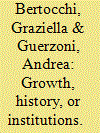

|
|
|
|
|
| Publication |
2012.
|
| Summary/Abstract |
This article explores the empirical determinants of state fragility in sub-Saharan Africa over the 1992-2007 period. Our dataset includes those sub-Saharan countries for which we have information on the distribution by quintiles of the World Bank Country Policy and Institutional Assessment (CPIA) ratings. We evaluate the potential influence on fragility of a wide range of economic, institutional, and historical variables. Among economic factors, we consider per-capita GDP, both in levels and growth rates, investment, natural resources, and schooling. We also consider economic policy variables such as government expenditures, trade openness, and inflation. Demographic forces are accounted for through the fertility rate, life expectancy, and the youth bulge. Institutional factors are captured by measures of ethnic fractionalization, civil liberties, revolutions, and conflicts, as well as governance indicators. Moreover, we select historical variables that reflect the colonial experience of the region, namely the national identity of the colonizers and the political status during the colonial period. Finally, we account for geographic factors such as latitude, access to sea, and the presence of fragile neighbors. Our central findings is that institutions are the main determinants of fragility: even after controlling for reverse causality and omitted variable bias, the probability for a country to be fragile increases with restrictions of civil liberties and with the number of revolutions. Before controlling for endogeneity, economic factors such as per-capita GDP growth and investment show some explanatory power, but economic prosperity displays a contradictory net impact since growth reduces fragility while investment facilitates it. Moreover, instrumental variables estimates show that per-capita GDP growth is no longer a significant factor. Colonial variables display a marginal residual influence: after controlling for all other factors former colonies are actually associated with a lower probability of being fragile.
|
|
|
|
|
|
|
|
|
|
|
|
|
|
|
|
| 7 |
ID:
117635


|
|
|
|
|
| Publication |
2012.
|
| Summary/Abstract |
Cyprus is a divided island. Despite the lack of a comprehensive peace agreement reunifying the country, in 2004 trade commenced across the Green Line that separates the Greek and Turkish Cypriot communities. The volume of trade has grown steadily since, but has it reached its full potential? First, a gravity equation is estimated by using an 'out-of-sample' estimation strategy to predict potential trade for the period from 2004 to 2009. We observe a sizable gap between potential and actual volumes of trade. We then attempt to account for this gap by analyzing economic, legal, and social-psychological barriers that can explain this difference. It is found that (1) actual trade has only reached around 10% of its potential, with (2) legal constraints accounting for 35% of the missing trade, (3) extra transportation costs for about 5%, and (4) unmeasurable and social-psychological barriers for a significant amount of between 48% and 60%, depending on the year. The findings suggest that attention must be paid to the objective barriers to trade as well as the subjective interpersonal and intercommunal perceptions that can affect trade and ultimately, peaceful resolution of the conflict. These findings have implications for other conflicts in which divided communities with the potential for trading across a shared border seek to maximize the joint economic and political gains of emerging interdependence.
|
|
|
|
|
|
|
|
|
|
|
|
|
|
|
|
| 8 |
ID:
117628


|
|
|
|
|
| Publication |
2012.
|
| Summary/Abstract |
Since the end of the Cold War, a global religious resurgence has transformed many aspects of world politics, including transnational activism, human rights, and terrorism. Yet, scholars still debate whether a generalizable influence of religion on interstate disputes exists. Despite significant progress in the study of religion and world politics, then, the fundamental question remains: under what conditions does the post-Cold War era's religious resurgence influence interstate disputes? This article points to the significance of institutional religion-state connections and ideological distance between disputants to account for the varied significance of religion in interstate conflicts. Religion influences conflict behavior when there are close ties between religion and the state and when a religious state is in a dispute with a secular state, creating ideological distance between the combatants. In such instances, the dispute is more likely to involve the use of force. The article tests this theory through a quantitative analysis of interstate disputes, using a Heckman probit model for the effects of religion-state connections on dispute severity. The tests reveal that while religious-secular dyads do not experience greater risks of conflict compared to other dyads, conflicts involving religious-secular dyads are more severe than those including other dyads, even when numerous competing explanations are accounted for. The article contributes to the study of religion and politics by highlighting the political factors that increase religious effects on international relations; it also contributes to the broader study of interstate crises by demonstrating the means through which ideas can affect interstate disputes.
|
|
|
|
|
|
|
|
|
|
|
|
|
|
|
|
|
|
|
|
|